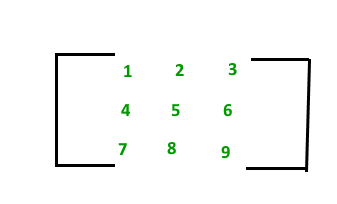Applications, Advantages and Disadvantages of Matrix Data Structure
Last Updated :
20 Feb, 2023
A matrix represents a collection of numbers arranged in an order of rows and columns. It is necessary to enclose the elements of a matrix in parentheses or brackets.
For example, A matrix with 9 elements is shown below.

Matrix
This Matrix [M] has 3 rows and 3 columns. Each element of matrix [M] can be referred to by its row and column number. For example, a23 = 6.
Types of Matrix:
There are various types of matrices. Some of them are:
- Row matrix
- Column matrix
- Null matrix
- Square matrix
- Diagonal matrix
- Sparse matrix
- Spiral matrix
- Identity matrix
- Triangular matrix
- Symmetric matrix
Features of Matrix Data Structure:
- Size: A matrix has a specific size, defined by its number of rows and columns.
- Element: A matrix’s row and column indices serve to identify each entry, which is referred to as an element.
- Operations: Scalar multiplication and the operations of addition, subtraction, and multiplication on matrices are also supported.
- Determinant: A square matrix’s determinant is a scalar number that may be used to solve systems of linear equations and carry out other linear algebraic operations.
- Inverse: If a square matrix has an inverse, it may be used to solve linear equation systems and carry out other linear algebraic operations.
- Transpose: By flipping a matrix along its main diagonal and switching the rows and columns, you may create the transpose of the matrix.
- Rank: In many applications, including the solution of linear equations and linear regression analysis, the rank of a matrix—a measure of its linearly independent rows or columns—is utilised.
Applications of Matrix Data Structure:
- Linear Algebra: Matrices are widely used in linear algebra, a branch of mathematics that deals with linear equations, vector spaces, and linear transformations. Matrices are used to represent linear equations and to solve systems of linear equations.
- Optimization: Matrices are used in optimization problems, such as linear programming, to represent the constraints and objective functions of the problem.
- Statistics: Matrices are used in statistics to represent data and to perform operations such as correlation and regression.
- Signal Processing: Matrices are used in signal processing to represent signals and to perform operations such as filtering and transformation.
- Network Analysis: Matrices are used in network analysis to represent graphs and to perform operations such as finding the shortest path between two nodes.
- Quantum Mechanics: Matrices are used in quantum mechanics to represent states and operations in quantum systems.
Real-Life Applications of Matrix Data Structure:
- Image processing: Matrices are extensively used in image processing for operations such as filtering, smoothing, scaling, and rotating images. In image processing, an image can be represented as a matrix of pixels, where each pixel corresponds to an element in the matrix.
- Robotics: In robotics, matrices are used to represent the position and orientation of robots and their end-effectors. They are used to calculate the kinematics and dynamics of robot arms, and to plan their trajectories.
- Transportation and logistics: Matrices are used in transportation and logistics to represent transportation networks and to solve optimization problems such as the transportation problem and the assignment problem.
- Finance: Matrices are used in finance to represent portfolios of assets, to calculate the risk and return of investments, and to perform operations such as asset allocation and optimization.
- Computer graphics and gaming: In computer graphics and gaming, matrices are used to represent 3D models, and to perform operations such as scaling, rotation, and translation. They are also used in lighting and shading effects.
- Electrical engineering: Matrices are used in electrical engineering for circuit analysis, control systems, and signal processing. They are used to represent systems of linear equations and to solve them using techniques such as Gaussian elimination and LU decomposition.
- Medical imaging: Matrices are used in medical imaging for operations such as image segmentation, registration, and reconstruction. They are used to represent medical images as arrays of pixels, and to perform operations such as smoothing and filtering.
- Cryptography: In cryptography, matrices are used for the encryption and decryption of messages. They are used in the Hill Cipher and other encryption techniques.
- Machine learning and artificial intelligence: Matrices are used in machine learning and artificial intelligence for data representation, modeling, and training of algorithms such as neural networks, support vector machines, and principal component analysis.
Advantages of Matrix Data Structure:
- It helps in 2D Visualization.
- It stores multiple elements of the same type using the same name.
- Elements can be accessed using an index.
- It enables access to items at random.
- Any form of data with a fixed size can be stored.
- It is easy to implement.
- It is the simplest 2D data structure.
- It is used by all programming languages.
Disadvantages of Matrix Data Structure:
- The matrix’s size must be known beforehand.
- It is of fixed size and its size can’t be modified further.
- Insertion and deletion operations are costly if shifting occurs.
- Memory wastage may result if the specified matrix size is more than what is required.
- Resizing a matrix can be time-consuming, especially if it needs to be done frequently or the size of the matrix is very large.
- No built-in functionality.
Share your thoughts in the comments
Please Login to comment...